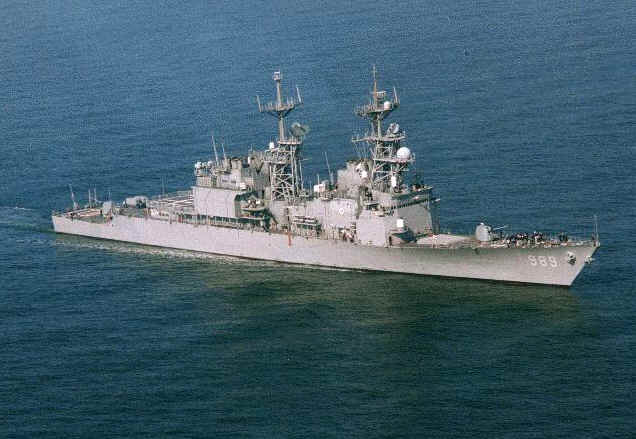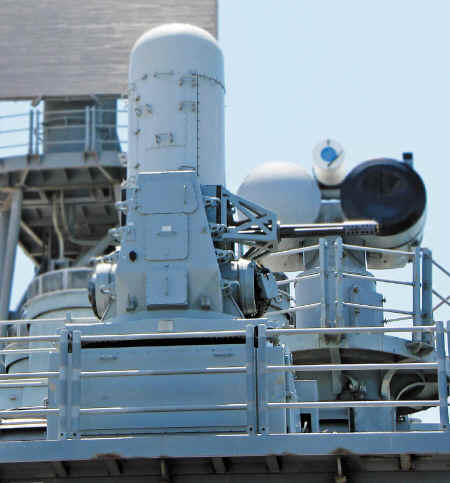Prior to an amphibious landing, a naval task force identifies and attacks every possible threat to the landing force. This includes anti-ship missile launchers, small patrol boats, mines, submarines, dug-in tanks, and laser-guided missile systems. The naval task force supporting the landing force will find most of these threats, but the rest will be discovered only when they open fire on the first ship that approaches shore, which is likely to be sunk. As surface combatants become more complex and expensive, risky missions are unwise.
Modern navies needn't risk a modern destroyer with 300 sailors aboard for such dangerous missions. Older destroyers are continually deemed outdated and scrapped. Some of these should be retained for "bait" missions. They can be stripped of all flammable materials so nothing can burn except fuel. They will have a minimal crew of around a dozen, or maybe none since US Navy uses the destroyer USS Foster as a weapons test ship that can operate with no crew aboard. A bait ship will have no working radar, no mess, no medical support, so it will be adopted by a sister ship that supports her, including rotating the small crew every few days. During peacetime, these ships will not deploy, but held in reserve. Maintenance will be minimal since only the propulsion system need work properly. Their crews need no training as their only mission is to cruise and man the CWIS to engage small boats, helicopters, incoming missiles, and shore targets. Bait ships may also have a method of broadcasting meaningless radar and radio signals to simulate an active destroyer.
 Empty spaces will be filled with flotation devices to make the ship much
harder to sink. Ping-pong balls are used to raise sunken ships. They are
literally pumped down inside the ship and fill it up until so much water is
displaced the ship rises. Ping-pong balls are flammable, yet any air filled
object
that will not catch fire can be used. They should be placed in large net bags and
affixed to walls or pipes so they cannot float outside if munitions punch
through. If a water-tight
compartment is hit, less than half will fill with water as the hollow fillers occupy most of the space.
Empty spaces will be filled with flotation devices to make the ship much
harder to sink. Ping-pong balls are used to raise sunken ships. They are
literally pumped down inside the ship and fill it up until so much water is
displaced the ship rises. Ping-pong balls are flammable, yet any air filled
object
that will not catch fire can be used. They should be placed in large net bags and
affixed to walls or pipes so they cannot float outside if munitions punch
through. If a water-tight
compartment is hit, less than half will fill with water as the hollow fillers occupy most of the space.
When operating as bait, the small crew will remain topside as much as possible in case of attack, and ready for action with fire resistant Nomex clothing, flak jackets, and helmets. They may have a twelve-man motorboat on deck to which they can flee should the destroyer sink rapidly. Their primary mission is to identify incoming munitions and report their source, which can be attacked by aircraft or naval gunfire from ships farther offshore. They will not try to save their ship as they haven't the manpower. However, this destroyer will be difficult to sink as there is nothing aboard that can explode and little that can burn except fuel.
If these ships are available, the command to "land the landing force" will be proceeded by "send in the bait." A sophisticated enemy may learn of the existence and purpose of bait ships, so their conversion and role should remain classified. They will be noted as older ships moved to a wartime reserve status. Even if the enemy is aware of bait ships, great discipline is required not to open fire on the first ship to come within range, especially when a CWIS (below) opens fire at possible targets ashore to provoke a fight. If an enemy refuses to take the bait, these ships can escort and shield a combat destroyer close to shore so that it can employ its weaponry, while it closely shadows the bait ship for protection.
 Bait ships are valuable for other roles as well.
They may test coastal defenses
with solo missions, cruising near shore while aircraft wait in the distance in
hopes of drawing small enemy patrol boats or attack helicopters out of hiding.
Anti-submarine warfare is another role for bait ships. A lone destroyer may seem
an easy kill for an attack submarine that does not know it is floating scrap
metal that will be difficult to sink. Finally, bait ships can lead other ships through lanes cleared of mines, just in case one was missed.
Bait ships are valuable for other roles as well.
They may test coastal defenses
with solo missions, cruising near shore while aircraft wait in the distance in
hopes of drawing small enemy patrol boats or attack helicopters out of hiding.
Anti-submarine warfare is another role for bait ships. A lone destroyer may seem
an easy kill for an attack submarine that does not know it is floating scrap
metal that will be difficult to sink. Finally, bait ships can lead other ships through lanes cleared of mines, just in case one was missed.
Bait ships will cost little to maintain. They will allow Admirals to act aggressively without fear of losing an expensive capital ship to surprise attacks. For example, should the United States go to war with Iran, admirals need a bait ship to send through the narrow Strait of Hormuz before risking any other ship. It should take numerous hits to sink a bait ship, thus exposing enemy defenses to attack and saving modern capital ships from damage. Since sophisticated anti-ship missiles can cost over a million dollars each, defenders have precious few to waste on bait ships. Ideally, a bait ship will prove its worth by attracting numerous munitions, then a helicopter can evacuate the dozen crewmen while the old ship scraps itself.
©2015 www.G2mil.com